Rearranging Icons 6: Images Of Man
 Why are Fred Warren and I still Rearranging Icons? Because icons fill our stories. Because the best readers will be aware of how others affect our minds with “iconography,” whether in novels, movies, religious traditions, or even television commercials. And because the best authors, who understand these transcendent symbols and know how to use them creatively, just might craft the best stories.
Why are Fred Warren and I still Rearranging Icons? Because icons fill our stories. Because the best readers will be aware of how others affect our minds with “iconography,” whether in novels, movies, religious traditions, or even television commercials. And because the best authors, who understand these transcendent symbols and know how to use them creatively, just might craft the best stories.
We’ll likely wrap up this series next week. Here, I’ll reply to Fred’s Tuesday column, with his comments indented. It seems like we’re closing in on a Grand Theory of Fiction Iconography: that good characters are striving to be icons. However, last week I did not mention something vital: a character never actually attains that status. (Only One has.)
Building icons
People can and will use [icons’] qualities to suit their own agendas, but I’m more interested in the idea that readers can have a richer reading experience and writers can tell richer, deeper stories if they understand how this works.
That leads me to ask, directly: what icons have readers noticed in their favorite novels or films? Or for writers: what icons have you intentionally placed in stories?
More often than not, [Protestant Christians have] forgotten what [icons] mean. On some level, the icon still communicates, but that communication is hindered when it’s taken out of context. It’s like slapping a facsimile of the Mona Lisa on a bumper sticker. More powerful is the iconography of our architecture. Our churches don’t resemble temples so much as lecture halls or convention centers. Big, white boxes with lots of chairs and a premium audiovisual system. Instead of cathedrals, we have “campuses.”
Such a name, resulting from such an supporting mindset, turns the church building into a Place of Learning. It seems to switch focus, from our exalted God whom we “gain” in any kind of true worship according to His self-revelation, to ourselves and our benefits.
One can legitimately critique Middle Ages-style cathedrals for their builders’ theology or means of fiscal support. But the concept of exalting God through excellence is Biblical.
I’d love to find more stories that act like miniature “cathedrals,” built for right reasons. Instead it seems that many Christian novels — not all of them, as overdone critiques say — act more like “campuses.” They have functional plain walls and office carpeting, yet not a whole lot of beauty meant to draw attention not to homework, but His work.
Moving from campuses and cathedrals, whether literal or metaphorical, to cottages.
[Stephen:] The better critics fault [Thomas] Kinkade not for imagining the perfect world of the future, when sin and death are over and Christ reigns, but for imagining and imaging a nonexistent “universe.” In the Kinkade-verse, serious sin never existed. Not only do you not have to worry about it now, you never did. I’m not sure how that provides true comfort, and reflections of God’s grace, to viewers.
I’m not buying your premise here. I don’t think Kinkade’s work has anything to do with sin, and I highly doubt he was consciously trying to image a perfect, sinless universe.
These quotes may help clarify my starting point. Kinkade did say he wanted to “portray a world without the Fall.” Interestingly, he also recognized his own paintings as iconic — something I wish I had read from him before writing last week’s column. “I want to build the new iconography for the coming millennium,” he said 12 years ago.
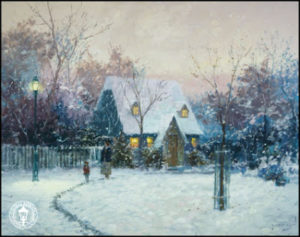
Kinkade used the lamp-post as an icon. You likely associate it with another wintry fantasy world.
Again — and especially not wishing to speak ill of him personally — legitimate Kinkade criticisms fault not the artist, but the viewer/consumer, for “making” his paintings into iconography that minimizes sin and therefore God’s victory over it. But if one viewer can abuse the art for sin, another viewer can certainly redeem it. I can enjoy a Kinkade painting, no matter how “sentimental,” for the same reason I can enjoy Avatar: The Last Airbender. A creator may have missed 50 percent of Biblical truth — but God has given His people enough truth to spare. We can easily fill in the rest, redemptively.
Where it falls down as art, I think, is that it doesn’t communicate much beyond the nice. Art surprises, challenges, even confuses at times. It’s meant to show us the world through new eyes and reveal things we haven’t noticed before by virtue of its creative perspective. A picture can be pretty and enjoyable (or ugly and shocking) without being particularly artistic or meaningful, but its utility, audience, and lifespan are limited.
Agreed. (See? It seems we’re still agreeing.) And therein lies the further problem: what happens when someone decides only one kind of iconographic art is the best, the most pure, or the most “Christian”? We end up elevating one kind of truth or beauty above another; our perspective is flattened. It would be like going through the Psalms and cutting out all the “all creation praises the Lord” chapters (these don’t talk enough about sin!) or else cutting out Christ’s mentions of Hell (these don’t remind us that God is love!).
[Stephen:] This may be why people are put off by Kinkade paintings, or novels that have clichéd characters. […]
Maybe, but I think it’s probably more about being hacked off that the kids are having chocolate cake for breakfast instead of something more nutritious.
You nailed it, brother. And I hope not to come across that way.
Chocolate cake is good. But if I had a child who only wanted to eat it for every single meal, only yelling at him about it is not the answer. The child needs to grow, in his maturity and in his understanding of other kinds of food. For example, what about chocolate chip cookie dough ice cream? Even among sweets, there’s more than one kind.
Reaching for iconhood
[Stephen:] Epic stories glorify our Author by showing the growth of characters into “icons.”
They can, but there aren’t many examples of characters, as compared to the total population, who actually manage this. And that’s okay. The community of characters we can rightly call icons in the truest sense of the word should be an elite group.
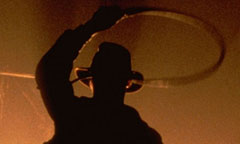
You instantly know who this is — even if his films' creator(s) kinda forgot.
It sounds like you were thinking in the sense of popular-iconic. Like shiny CGI blue people with large over-friendly golden eyes. Or Indiana Jones’ hat. Or Superman’s cape.
By contrast, I’d been thinking about this first in the sense of a character trying to be like the ultimate Character/Icon, Christ (or a fantasy-world equivalent). Yet this is similar to a character who wants to be like an idealized icon in his story-world. Luke wants to be the best Jedi Knight. Peter Parker wants to be a great superhero. Aang wants to fulfill his mission as the Avatar, master of all four elements among the four nations. All of those are in a sense quests for “perfection.” They’re what drives the character’s actions.
Similarly, for the Christian, fighting bad guys, discerning wrong beliefs, or even enjoying beauty are all means to the greater end: Perfection Himself. Christian characters, or their fantasy-world equivalents, are much the same.
The icon is a point of reference, a target, a bar set a few inches above our personal best.
Exactly. And it seems that in reality and stories, the threshold of “perfection” will always be higher than the person can ever reach. Christ is in His place and we’re in ours, unable to rise further because He was first and always. In reality, we should prefer it that way.
[Stephen:] A character is a human figure, shown, described and/or followed in an artwork, song, movie, play, or novel. Unlike icons, a character is not ideal. He or she is “real world,” with all the limitations, likely even sins, that we would expect.
Fair enough, but I don’t quite agree with this:
[Stephen:] A character is trying to be an icon, an image of the Greater, but hasn’t yet arrived. This leads to a story’s plot. Heroes (and even villains) have not yet achieved their goals.
From the character’s point-of-view, I don’t see this happening very often. Characters are mostly trying to just live their life, or survive to see another sunrise. Their personal growth is something they don’t realize until near the end of their story, though that journey is visible to the reader and part of what keeps us engaged.
It depends on the story type. If it includes a Christian character (or fantasy-world equivalent), he is indeed on a conscious mission. It’s not just about survival, but of proactive battle against his own nature and external enemies, and desire to please and become like the One Who saved him. Of course, all that is a grandiose simplification, because often that grand battle appears very dull in one’s life!
The best stories may reflect this in their characters. It can also provide amusement. On his way to a grand struggle against the dark lord to save the realm, the hero gets a rip in the seat of his battle-armor. …
[Stephen:] Icons are for ideals, and the Ideal God. Not for us. Not for characters who “image” us.
Okay, this begins to touch on something important, I think. In one sense, you’re right—we can’t make ourselves perfect images of God, nor can we fashion “iconic” characters through the force of our own talent and will. Human beings become conformed to the image of God through His power and grace and our cooperation with His work in our lives. We’ve already discussed how all Christians serve as icons of Christ, even imperfectly. Some progress farther on the journey than others in this life. A few may serve as models and exemplars, heroes and heroines of the faith for those of us who follow, long after their death.
Amen. Thus, as I wrap up, a summary of one “formula” resulting from this series.
- God is the Axiom, the image of no one. He is Himself, the I AM.
- Jesus Christ, fully God and fully Man, the second Person of the Trinity, in His eternal existence as the God-Man, is the “icon” of God (Col. 1:15; Heb. 1:3).
- As redeemed saints, Christians are “icons” of Christ (Rom. 6:5, 1 John 3:2).
- Likewise, story characters are “icons” of us, in their complexities and choices.
But there’s also another dimension for characters in a story: the audience gets a vote. Characters don’t land on the bookshelf as freshly-minted icons on the day of publication. Millions of readers, over years, and even centuries, make that decision in consensus.
That could bring on the beginnings of other I-hope-even-deeper thoughts: that people appreciate character icons as they reflect us and “vote” to make them greater, in ways reminiscent of how Christ loves the Church’s members and makes them even greater.
Just as Christ wants us, His “icons,” to exalt the Father and be one with Him as He and the Father are One (John 17:20-23), so we will want to exalt favored iconic characters.
Back over to you, brother Fred.
Over also to readers, for further thoughts about icons in their favorite fiction. Who do you like? Who is already “iconic” in popular story franchises? Who should be iconic — perhaps a lesser-known character who you believe “images” you most uniquely?






























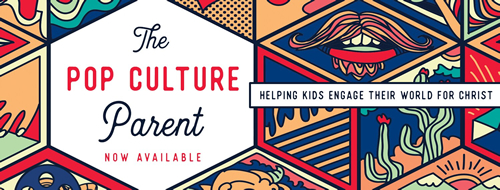

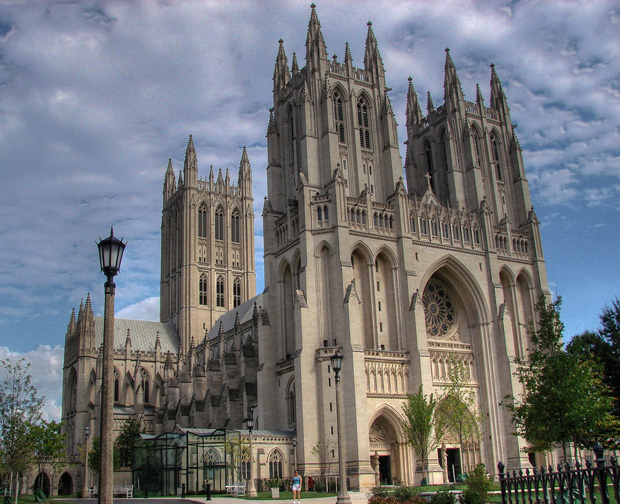



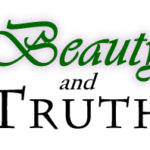



Wow…there’s so much to reflect on here that I’m not entirely sure where to begin or what to say…mark of a good blog post, I suppose. To focus on one aspect, that of icons placed in stories–I have one that is a strange hybrid. The story grew from an image of three roses darker than black and more vivid than crimson. They represent the King, and the people of the story belive that, but then outside the story, I realize they’re more of a Holy Spirit sort of thing. Which I did not know when I was writing it, but kind of hit me one day.
I’m sorry I couldn’t reply sooner. This topic deserves some discussion! I was busy, and it took me a while to come up with this:
One of my favorite archetypes or icons is the True Seeker — the person desperate to find meaning and truth, and not willing to accept easy or partial answers, someone absolutely certain that there is a greater destiny. I give two examples of this icon, both from television shows — Fox Mulder from The X-files, and Jeffrey Sinclair from Babylon 5. (I got the term “True Seeker” from a Bab-5 episode, too ;)).
From Galadriel:
Or another kind of blog post — one that says too much! 😀
Recently I was reading about the idea of the MacGuffin — an object that drives the plot of characters’ quest, without a whole lot of explanation. It would seem that if I’ve thought this out right, we’ve found the opposite of a legitimate story icon or symbol, an imposter. Icons make sense; they have meaning. But MacGuffins make little sense.
If I’d had time, I would have explored the iconography C.S. Lewis evidently used when writing the Ransom Trilogy and Chronicles of Narnia series. Lewis believed that archetypes represented by the medieval planets — Jupiter, Mars, Sol, Luna, Mercury, Venus, and Saturn — were being lost in modern society, and that we really ought to recover those timeless mythologies. Author Michael Ward in Planet Narnia argues that Lewis, by accident and then by intention, based each of the seven Chronicles on one of these medieval planets. No, it’s not a superstitious Da Vinci Code-type theory, and no, this doesn’t nullify the Chronicles‘ Christianity, Ward suggests. Rather, Lewis was doing what he always did: taking ancient mythology “captive” in service of Aslan/Christ.
Anyway, because much Christian fantasy is inspired on Narnia, it seems authors could:
Lewis was Lewis, and authors shouldn’t all try to “be” him. Yet authors or readers who wish to follow in his thoughts need to explore ancient mythology, and Art and all that.
Actually, that makes a lot of sense. As a frequenter of TV Tropes, I see a lot of references to MacGuffins and such…but I never though of it as the opposite of an icon.